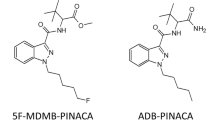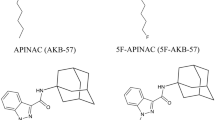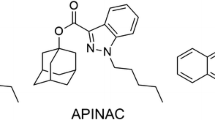Summary
Metabolites of CBD excreted into the bile and perfusion fluid were examined in a rat liver perfusion preparation. Metabolites were extracted with ethyl acetate and identified by GC/MS as TMS derivatives. Four mono- and five di-hydroxy metabolites were identified with major sites of metabolic attack being at C-7 and C-4″. A hydroxy-ketone was detected but not fully identified. All biliary metabolites were conjugated with glucuronic acid. Urinary metabolites were studied in rats with samples taken at times to 25 h after drug administration. Unmetabolized CBD and 13 metabolites were identified by GC/MS. Major metabolites were acids with beta-oxidation being a prominent pathway. The 6- and 7-hydroxy derivatives of 4″, 5″-bis,nor-CBD-3″-oic acid were the most abundant compounds but substantial concentrations of the di-acids, CBD-5″,7-dioic acid and 4″,5″-bis,nor-CBD-3″,7-dioic acid were present. Concentrations of the more highly oxidized metabolites increased with time.
Similar content being viewed by others
References
Turner C.E., ElSohly M.A., Boeren E.G. (1980): Constituents ofCannabis sativa L., XVII. A review of the natural constituents. J. Nat Prods., 43, 169–234.
Razdan R.K. (1986): Structure-activity relationships in cannabinoids. Pharmacol. Rev., 38, 75–149.
Consroe P., Snider S.R. (1986): Therapeutic potential of cannabinoids in neurological disorders. In: Mechoulam R. Ed. Cannabinoids as Therapeutic Agents. Boca Raton, CRC Press, pp. 21–49.
Martin B., Nordqvist M., Agurell S., Lindgren J.-E., Leander N., Binder M. (1976): Identification of monohydroxylated metabolites of cannabidiol formed by a rat liver. J. Pharm. Pharmacol., 28, 275–279.
Martin B, Agurell S., Nordqvist M., Lindgren J.-E. (1976): Dioxygenated metabolites of cannabidiol formed by rat liver. J. Pharm. Pharmacol., 28, 603–608.
Martin B.R., Harvey D.J., Paton W.D.M. (1977): Biotransformation of cannabidiol in mice: identification of new acid metabolites. Drug Metab. Dispos., 5, 259–267.
Harvey D.J., Martin B.R., Paton W.D.M. (1980): Identification of in vivo liver metabolites of delta-1-tetrahydro-cannabinol, cannabidiol and cannabinol produced by the guinea pig. J. Pharm. Pharmacol., 32, 267–271.
Robertson L.W., Huff S.R., Ghosh A., Malhottra R. (1978): Acidic biotransformation products of cannabinoids produced byMycobacterium rhodochrous. Lloydia, 41, 659.
Robertson L.W., Koh S.W., Huff S.R., Malhottra R.K. (1978): Microbiological oxidation of the pentyl side-chain of cannabinoids. Experientia, 34, 1020–1022.
Samara E., Bialer M., Harvey D.J. (1990): Identification of urinary metabolites of cannabidiol in the dog. Drug Metab. Dispos., 18, 1065–1076.
Harvey D.J., Mechoulam R. (1990): Metabolites of cannabidiol identified in human urine. Xenobiotica, 20, 303–320.
Harvey D.J., Paton W.D.M. (1984): Metabolism of the cannabinoids. Rev. Biochem. Toxicol., 6, 221–264.
Meijer D.K.F., Keulemans K., Mulder G.J. (1981): Isolated perfused rat liver technique. Methods Enzymol., 77, 81–94.
Harvey D.J., Martin B.R., Paton W.D.M. (1977): Identification of di- and tri-substituted hydroxy and ketone metabolites of delta-1-tetrahydrocannabinol in mouse liver. J. Pharm. Pharmacol., 29, 482–486.
McCloskey J.A., Stillwell R.N., Lawson A.M. (1968): Use of deuterium labelled trimethylsilyl derivatives in mass spectrometry. Anal. Chem., 40, 233–236.
Harvey D.J. (1987): Mass spectrometry of the cannabinoids and their metabolites. Mass Spectrom. Rev., 6, 135–229.
Binder M., Agurell S., Leander K., Lindgren J.-E. (1974): Zur Identifikation potentieller Metabolite von Cannabis-Inhaltstoffen: Kernresonanz und massenspektropische Untersuchungen an seitenkettenhydroxylierten Cannabinoiden. Helv. Chim. Acta, 579, 1626–1641.
Harvey D.J. (1981): The mass spectra of the trimethylsilyl derivatives of the hydroxy and acid metabolites of delta-1- and delta-6-tetrahydrocannabinol. Biomed. Mass Spectrom., 8, 579–588.
Samara E., Bialer M., Harvey D.J. (1990): Identification of glucose conjugates as the major urinary metabolites of cannabidiol in the dog. Xenobiotica, 20, 177–183.
Author information
Authors and Affiliations
Rights and permissions
About this article
Cite this article
Samara, E., Bialer, M. & Harvey, D.J. Metabolism of cannabidiol by the rat. European Journal of Drug Metabolism and Pharmacokinetics 16, 305–313 (1991). https://doi.org/10.1007/BF03189976
Received:
Issue Date:
DOI: https://doi.org/10.1007/BF03189976




